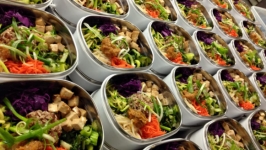Chefs and Consumers Shift to Plant-Forward Eating and Cuisine
If you’re trying to get more fruits and vegetables into your diet in 2019, you’re not alone. A recent Nielsen survey found that 39% of Americans are actively trying to eat more foods that come from plants.
That’s a big change for most Americans, who are among the top meat eaters in the world. Whether motivated by increasing awareness of the health benefits of nutrient-rich fruits and vegetables or concern about the humane treatment of animals (thank you Michael Pollan and Mark Bittman), people are looking for healthier ways to eat.
The health benefits of eating fruits and vegetables are undeniable but it is easy to feel guilty about not consuming five servings of produce a day. Even worse—what if you eat meat at lunch and dinner? It gets even harder when dining out, and trying to determine how the items on a menu fit into your plans to eat a plant-forward diet.
What is Plant-Forward Eating?
There’s an evolving culinary lifestyle that bridges the vegetarian and the omnivore worlds and it might describe the kind of healthy eating habits you’re trying to follow, with plants at the forefront.
It’s called “plant-forward,” a type of cooking and eating that emphasizes fruits, vegetables, whole grains, beans, legumes and nuts—and recognizes that animal proteins can still be included, just in smaller portions. And it changes our thinking by putting vegetables and plants first in our menu planning and main dish meal selections.
Instead of placing meat at the center of the meal, delicious plant-based foods dominate the plate. Meat is used sparingly, as a flavorful ingredient in a dish or simply consumed in small portions.
It’s a culinary choice you can follow at home cooking your own meals. And increasingly, you’ll be able to stick to this mindful way of eating when you dine out.
Menus of Change Initiative
Chefs in restaurants, college dining halls, corporate cafeterias and even ballparks are increasingly getting creative in bringing sustainable, healthy and delicious dining options to consumers—and are helping shape a healthier American diet at the same time.
Leading the charge for plant-forward choices when dining out is the 6-year-old initiative called Menus of Change (MC), started by the Culinary Institute of America (CIA) and the Harvard T.H. Chan School of Public Health—and extended to numerous universities by Stanford through the MC University Research Collaborative.
Through evidence-based research on health and sustainability, Menus of Change is working with the culinary profession and food service industry to emphasize plant-based foods in the menus they put before diners. The goal is to make more healthy choices available and ultimately develop a healthier culinary palate.
“Americans still eat a lot of red meat, the equivalent of three hamburgers a week,” said Sophie Egan, who heads up health and sustainability leadership at the CIA. “We know it’s not realistic for people to turn into vegetarians overnight and restrictive diets are usually only adopted for a short time. A plant-forward diet is much more flexible and still fits in with a healthy lifestyle.”
Stanford co-founded the Menus of Change University Research Consortium to leverage the unique position of universities to advance healthier, more sustainable and plant-forward choices among students who will soon be parents and adult decision makers themselves.
The Collaborative is providing university food service chefs with a plethora of recommendations on sustainable sourcing, portion size, limits on dairy and eggs and the health benefits of legumes, herbs and “pulses”—a term for dried beans and lentils.
It’s conducting multi-site research on healthy food systems, including studies to find out just how to entice students to eat more plant-based foods.
A major finding: Words matter. How a dish is described will make or break its popularity among student diners. Leading with flavor works; using terms like “low fat,” “healthy,” “nutritious” and “meatless” doesn’t.
A study conducted at the University of California at Davis brought this home.
Students were offered different kinds of carrots at a self-serve station. Choices were labeled “carrots,” “healthy carrots,” “low-sodium carrots” and “twisted citrus glazed carrots.” All were identically prepared, but guess which one disappeared while the others were left over? You guessed it—the carrots that sounded delicious.
One of the national food service companies that have long supported plant-based cuisine is Palo Alto–based Bon Appétit Management Company, the firm whose chefs prepare tens of thousands meals daily in cafés for more than 40 Silicon Valley corporations such as LinkedIn, Google, Adobe and Oracle as well as Santa Clara University and University of San Francisco. In addition to using flavor-forward descriptions in their menus, they’ve creatively found ways to get more plant-based food into their dishes.
“Our cook-from-scratch method allows us to practice ‘stealth health’ with abandon,” said Terri Brownlee, director of nutrition and wellness for Bon Appétit. “Our chefs love to sneak healthy ingredients into traditionally indulgent dishes without sacrificing flavor (think vegetables in meat loaf, a blended mushroom-beef burger, or even black bean brownies), creating a quietly health-promoting food environment that leaves guests craving more, while fueling them for their best performance.”
Plant-Based Side Dishes—No Longer Sidelined
Most menus prepared at home or in restaurants start with a decision on which animal protein will be served. Chicken, fish and meat are the obvious stars on the plate, and the vegetables, legumes or grains are seen as the supporting actors. Restaurant servers ask, “Would you like a side salad or a side of spinach with your steak?”
But plant-forward cooking takes that question off the plate. A gorgeous herb-crusted cauliflower steak with beans and tomatoes, or portobello mushrooms with sautéed Asian pears and cherries becomes the centerpiece of the menu.
Top chefs see vegetables as an exciting fresh canvas for experimentation and hearty main dish entrées to spotlight on their menus.
“There’s an opportunity for almost unlimited creativity with the different kinds of produce available to us for new menus,” said Jarad Gallagher, executive chef at Mountain View’s Michelin-starred Chez TJ restaurant. “That’s because there are many more varieties of vegetables than there are varieties of animal protein.”
Menlo Park–based Flea Street Café has long been known for preparing “clean” meals that use less animal and fish protein and more plants. “We absolutely ‘shift the center of the plate’ by making offerings more plant-based,” says owner Jesse Ziff Cool. “We create dishes where ingredients besides the protein on the plate are equally as delicious and worthy of every bite. It’s both challenging and exciting.”
Where does meat come in? It certainly has its place on the plate, either in small portions— commonly two to three ounces, or the size of a deck of cards—or as a star flavoring ingredient and condiment.
Using meat as a flavoring agent is common in food cultures around the world. According to well-known food journalist Mark Bittman, “This was true in American frontier cooking, where salt pork and bacon were used to season beans; in Italy, where a small piece of meat is served as a secondo (rarely more than a few ounces, even in restaurants); and around the world, where bits of meat are added to stir-fries and salads, as well as bean, rice and noodle dishes. In all of these cases, meat is seen as a treasure.”
“Compare these statements,” he suggests. “‘We’re grilling a leg of lamb tonight and throwing a few vegetables on there’ and ‘We’re grilling vegetables and breads, and will throw a few chunks of lamb on there.’ If you see meat as a treasure, things change.”
It’s taking time, but the American diet is slowly turning toward healthy, sustainable and mindful eating. With a plant-forward culinary approach as a guide, your spring-forward menus will undoubtedly be delicious, and put your healthier eating plan into high gear.





